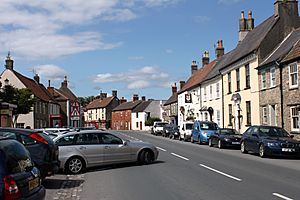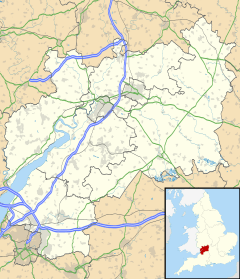Wickwar facts for kids
Quick facts for kids Wickwar |
|
|---|---|
 Wickwar High Street |
|
| Population | 2,083 (2021 census) |
| OS grid reference | ST7288 |
| Civil parish |
|
| Unitary authority | |
| Ceremonial county | |
| Region | |
| Country | England |
| Sovereign state | United Kingdom |
| Post town | WOTTON-UNDER-EDGE |
| Postcode district | GL12 |
| Dialling code | 01454 |
| Police | Avon and Somerset |
| Fire | Avon |
| Ambulance | Great Western |
| EU Parliament | South West England |
| UK Parliament |
|
Wickwar is a village in Gloucestershire, England. It is located between the towns of Yate and Charfield. In 2021, about 2,083 people lived there. It is also a "civil parish," which is a local area with its own council.
Contents
A Look Back in Time
Wickwar is an old village. It was first mentioned in the Domesday Book in 1086. This was a big survey of England ordered by William the Conqueror. Back then, it was called 'Wichen'. This name meant 'at the dwellings'.
The land was given to a person named John la Warre by King John. The "Warre" part of the family name later became part of the village's name, Wickwar.
The Old Saltway and Market
Wickwar was once on an important path called the Old Saltway. This path was used to carry salt from Droitwich to other places. In the 1200s, the de la Warre family helped the village grow. They started a market in 1285.
The main street, which is now High Street, was built around this market. Houses were set up with special plots of land called "burgage plots." People who lived in these houses were called "burghers." They paid rent and had their own businesses. They often kept animals in their backyards. This is why there were lanes behind the houses.
Early Village Life
The very first part of Wickwar was near the church and a large house called Poole Court. Poole Court was built in the 1500s but was taken down in the 1800s. Only its terraced garden remains today.
Important Buildings and Places
Holy Trinity Church
The village church is called Holy Trinity. It sits on a small hill. The church was first built in the 1100s. It was changed a lot in the 1300s and 1400s. It was also fixed up in the late 1800s.
To get to the church, you walk on a raised path called the Stank. This path used to be a dam for fish ponds. Inside the church, there is a sculpture of St John the Baptist from 1496. This sculpture used to be at Poole Court. The church is a special old building, known as a Grade II* listed building. This means it is very important for its history and looks.
Other Historic Buildings
Near the church, in the churchyard, is the Sunday School. It was built in 1837 in a style called Gothic revival. This style looks like old medieval churches. The churchyard also has many old stone tombs.
High Street has many houses from the 1700s. They often have a smooth, painted finish. The Town Hall was built around 1795. It has arched doorways and a small tower with a bell. The clock in the Town Hall might be from as far back as 1660!
Transport and Shops
Wickwar is on the main Bristol–Birmingham railway line. It used to have a train station, but it closed in 1965. The village also used to have a shop and a brewery. These both closed in recent years. Now, the village does not have any shops. There is a Wickwar Social Club, but it is only for members.
How Wickwar is Governed
Wickwar is part of an area called 'Ladden Brook' for local elections. This area also includes Iron Acton and Tytherington. In 2011, about 3,858 people lived in this larger area.
Recent Events
1987 Gas Explosion
On January 9, 1987, a gas pipe under High Street exploded. It destroyed one house and damaged others. Luckily, no one was hurt. An off-duty policeman smelled the gas and warned people to leave before the explosion happened. His own house was destroyed.
After this event, large trucks were not allowed to drive through the village. People thought that heavy trucks, along with cold weather, might have caused the old pipes to break.
Geronimo the Alpaca
In August 2021, a farm in Wickwar became well-known because of an alpaca named Geronimo. Geronimo had a health issue. The DEFRA, a government group, decided that Geronimo needed to be put down. On August 31, 2021, staff from the Animal and Plant Health Agency (APHA) did this.
See also
 In Spanish: Wickwar para niños
In Spanish: Wickwar para niños


